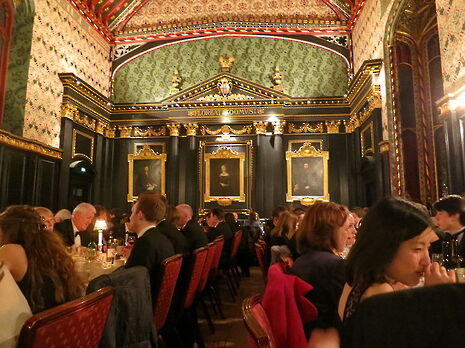College paintings: an alienating reminder of Cambridge’s past
Why not represent and document contemporary history that recognises the importance of diversity and inclusion? asks Ruby Reding, as she explores the impact of the works of art that hang on our college walls

The painting in Trinity College of Isaac Newton by James Thornhill is really interesting. It glows golden in an unusual way and has a sky and horizon in the background that easily hides itself, appearing delicate and tranquil. Thornhill’s paintings are widely recognised as integral to the Baroque style of painting, and I remember seeing some in a book at school for the first time in year 11. But for most people, the page of a book is as close as they come to experiencing a painting like this, let alone sitting down to eat casually in front of it without even glancing up.
When a friend at Cambridge told me that the Virgin Queen painting of Elizabeth I was hung above Trinity College’s high table in October last year, I was firstly amazed that this fact could be true (I was a fresher); and secondly, I thought it was great that there was some female representation going on.
But ultimately the idea that you should eat every day in the presence of something so grand and classical was really daunting and unfamiliar. I don’t want to rely too heavily on my own experiences of feeling isolated and unsettled at Cambridge, because I’m white and middle class so I reflect the majority of other students here. I can say, however, that if I felt amazed, overwhelmed and intimidated by the interiors in my first few weeks here coming from a state school in London, then I can’t begin to comprehend the experiences of those who face this kind of alienation in the wider world outside of Cambridge.
Part of this amazement at seeing so many dated oil paintings comes from an appreciation of the significance and history of the art, so why not also represent and document contemporary history that recognises the importance of diversity and inclusion? If the artwork in college halls is a marker of the “political, cultural and intellectual context” in which Cambridge and its colleges has developed, as Trinity College’s website states, then surely there should also be a marker for the development towards a more diverse body of fellows and students. As well as this, the amazing activism going on by BME, LGBT+ and women’s campaigns should get the recognition and record they deserve. Not all students in Cambridge stride out of Eton anymore, and so the art should reflect that the student body and political climate has likewise changed (sort of).
I think it’s also important to establish when art should take on different responsibilities in different spaces. For instance, the New Hall Art Collection at Murray Edwards is the largest body of women’s art in Europe, which is pretty amazing. It houses works from Tracey Emin to Ghisa Koenig. These pieces, however, are in an exhibition space and do not line the walls of halls, corridors and offices. It’s impossible to expect art to be representative everywhere, but when it’s placed in a different social context it must take on different responsibilities.
In addition to this distinction, I think we must also recognise that art is inherently politicised, because of the disparity in opportunities available for artists who aren’t privileged, white and male. The problem lies not just in what is visually apparent in artwork, but also the guise of what goes on behind gallery walls. As the Guerilla Girls point out, this problem is institutional in the social and economic realm of art. The Guerilla Girls are a group of female artists who have been campaigning for gender equality in the art world since 1985. They have recently revived old campaigns, and currently have an exhibition at the Whitechapel gallery in London, curated by Xavier Arakistain and Nayia Yiakoumaki. The title of the exhibition is Is it even worse in Europe? and is on until 5th March 2017. This exhibition is evidence of how these issues can’t be left in 1980s feminism. I would highly recommend visiting it.
I also don’t want to dismiss the work that has been and is being put in place to transform the interiors of Oxbridge. For example, photography portraits of female fellows in a series called Portraits that Matter by Fran Monks have been hung in the hall of St Peter’s College in Oxford, among other works such as a portrait of the first female bishop in the Church of England. Homerton College’s collection of art is also a lot more diverse.
The problem of comfort, security and acclimatisation for students from different backgrounds, compared with the ones more accustomed to Cambridge’s grandeur, is a much greater and inherent problem in universities than the old paintings that hang solemnly on the walls of college halls. But if some of the peeling oil paint of dead white men was replaced with contemporary art, or even more representative traditional art, then I truly believe the halls here would seem less intimidating. Culture and art are political, and even more so when displayed in institutions renowned for elitism. Cambridge cannot deny this problem forever
 Comment / Not all state schools are made equal 26 May 2025
Comment / Not all state schools are made equal 26 May 2025 News / Uni may allow resits for first time24 May 2025
News / Uni may allow resits for first time24 May 2025 Fashion / Degree-influenced dressing25 May 2025
Fashion / Degree-influenced dressing25 May 2025 News / Clare fellow reveals details of assault in central Cambridge26 May 2025
News / Clare fellow reveals details of assault in central Cambridge26 May 2025 News / Students clash with right-wing activist Charlie Kirk at Union20 May 2025
News / Students clash with right-wing activist Charlie Kirk at Union20 May 2025





